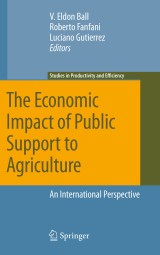Details

The Economic Impact of Public Support to Agriculture
An International PerspectiveStudies in Productivity and Efficiency, Band 7
|
149,79 € |
|
| Verlag: | Springer |
| Format: | |
| Veröffentl.: | 27.07.2010 |
| ISBN/EAN: | 9781441963857 |
| Sprache: | englisch |
| Anzahl Seiten: | 348 |
Dieses eBook enthält ein Wasserzeichen.
Beschreibungen
Despite a gradual and sustained decline in the contribution of agriculture to the economies of the member countries of the Organization for Economic Cooperation and Development (OECD), the sector remains socially and politically important. Although agriculture accounts for less than 2% of the gross domestic product of the OECD countries, it occupies over 35% of their total land area. Predominantly rural regions, where agriculture remains particularly important, contain almost one quarter of the population of OECD countries. The past quarter century has witnessed signi?cant changes in agricultural po- cies in OECD countries. Although total support remains high, a shift has taken place from price-linked measures to direct income support, most notably in the European Union. Policies have been adapted to meet pressing social concerns, such as ens- ing food security and improving environmental quality. OECD countries face major economic issues due to the ageing of their populations and the need to adapt to gl- alization and increasing competition from emerging economies. Continued pressure to reform agricultural policies will be exerted by the need to economize on the use of scarce public resources. At the same time, agriculture faces new challenges g- erated by climate change, the “greening” of the economy, increasing scarcity of energy and water, and the demands placed on the food system by an expanding world population.
and Overview.- and Overview.- New Directions in Agricultural Policy: US and European Perspectives.- Recent Developments and Applications from the OECD Toolbox.- US and EU Agricultural Policy: Divergence or Convergence?.- The “Health Check” of the CAP Reform: Lessons from Its Impact Assessment.- The Incidence of US Farm Programs.- Agricultural Policy and Economic Performance.- Impact of Subsidies on Farm Productivity and Efficiency.- Productivity and Profitability of US Agriculture: Evidence from a Panel of States.- Energy and Agricultural Policy.- Biofuels Expansion in a Changing Economic Environment: A Global Modeling Perspective.- Ethanol and Corn Prices: The Role of US Tax Credits, Mandates, and Imports.- Modeling the Effects of U.S. Biofuel Policies on Commodity and Energy Markets.- Biofuels Versus Food Competition for Agricultural Resources: Impacts on the EU Farming Systems.- International Trade and Domestic Agricultural Policy.- WTO Compliance and Domestic Farm Policy Change.- Agricultural Competitiveness.- The Behavior of Relative Food Prices: An Analysis across the European Countries.- Commodity Programs and Risk Management.- The Political Economy of the US Crop Insurance Program.- Aggregation and Arbitrage in Joint Production.- Standard and Bayesian Random Coefficient Model Estimation of US Corn–Soybean Farmer Risk Attitudes.
The recent reforms of the Common Agricultural Policy (CAP) of the European Union extend in a significant way the “decoupling” process started some ten years earlier. By adopting the Single Farm Payment (SFP) scheme only limited support for agriculture is tied to current production decisions. This is also true of U.S. farm policy. The reform act of 1996 introduced greater planting flexibility, shifted some support to direct payments, and eliminated the authority for acreage reduction programs. The 2002 and 2008 Acts retained these features. However, they added countercyclical components to direct payments based on market prices and historic production, and allowed for updating of base acreage underlying direct payments. These steps arguably reintroduced ties between support and production decisions. This volume explores the economic implications of these recent changes in the design of agricultural policies for the economic performance of the sector in the European Union and the United States.
The book is organized around five themes: (1) New Directions in Agricultural Policy: U.S. and EU Perspectives; (2) Agricultural Policy and Economic performance; (3) Energy and Agricultural Policy; (4) International Trade and Agricultural Policy; and (5) Commodity Programs and Risk Management. The authors apply rigorous tools to analyze the impact and implications of current agricultural policies on efficiency, productivity, and competitiveness in the sector, and consider opportunities for improvement in policymaking and practice.
The book is organized around five themes: (1) New Directions in Agricultural Policy: U.S. and EU Perspectives; (2) Agricultural Policy and Economic performance; (3) Energy and Agricultural Policy; (4) International Trade and Agricultural Policy; and (5) Commodity Programs and Risk Management. The authors apply rigorous tools to analyze the impact and implications of current agricultural policies on efficiency, productivity, and competitiveness in the sector, and consider opportunities for improvement in policymaking and practice.
Brings together insights from experts in economics, international trade, agricultural policy, and statistics to assess the current state of the agricultural and bio-fuels sector Analyzes recent agricultural policy reforms in the U.S. and the EU, with respect to both research and practical/policymaking implications The first book to apply rigorous concepts of productivity and efficiency analysis to agriculture policy Includes supplementary material: sn.pub/extras
Diese Produkte könnten Sie auch interessieren:

Agricultural Biodiversity and Biotechnology in Economic Development

von: Joseph Cooper, Leslie Lipper, David Zilberman

213,99 €

Policy Reforms and Agriculture Development in Central Asia

von: Sandjar Djalalov, Suresh Chandra Babu

213,99 €

Regulating Agricultural Biotechnology

von: Richard E. Just, Julian M. Alston, David Zilberman

213,99 €













